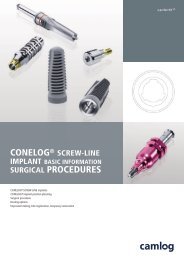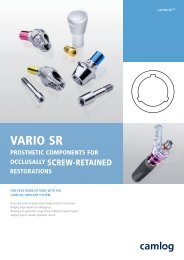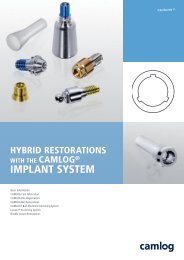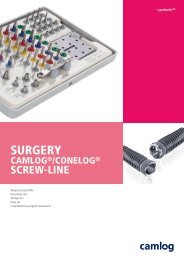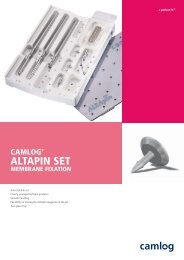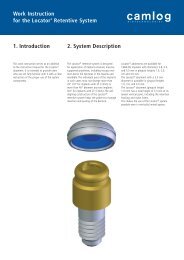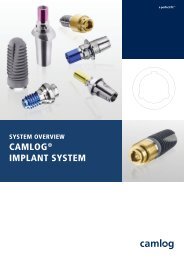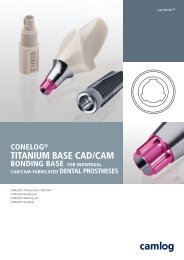CONELOG® Implant System Prosthetic Restorations - Camlog
CONELOG® Implant System Prosthetic Restorations - Camlog
CONELOG® Implant System Prosthetic Restorations - Camlog
Create successful ePaper yourself
Turn your PDF publications into a flip-book with our unique Google optimized e-Paper software.
PREPARATION<br />
Abrasive wheels suitable for titanium machining are used for the preparation.<br />
For fine preparation and to create the chamfer, we recommend finely<br />
toothed titanium milling cutter. For grinding, the speeds recommended by<br />
the respective manufacturer of the abrasive particles should be maintained.<br />
Use only low pressure to avoid overheating the titanium. Overheating<br />
causes a heavy «alpha-case» layer to form. It is very hard and can make further<br />
processing difficult.<br />
First, the abutment height and axial inclination are adapted, then followed<br />
by preparation similar to standard chamfer preparation of a tooth stump<br />
based on the perioprosthetics. The ideal preparation angle is approx. 2–4°.<br />
For esthetic reasons, the crown margin should lie vestibular 1–1.5 mm subgingivally.<br />
CAUTION!<br />
To safely remove any remaining cement, the cement gap should not lie<br />
deeper than 1.5–2.0 mm subgingivally for cemented restorations.<br />
During the preparation process, we recommend to return the abutment into<br />
the cast and use the silicone index to check the forming. At the conclusion<br />
of the modification, the ground surface is smoothed (e.g. with a gumming<br />
unit).<br />
CONELOG ® IMPLANT SYSTEM<br />
PROSTHETIC RESTORATIONS<br />
TIP: To make later integration of the crown easier and to ensure antirotational<br />
support, the preparation cross-section should not circular, but oval<br />
similar to the root cross-section of the natural teeth and include a milled<br />
conical guide groove.<br />
TIP: To make orientation/alignment easier when inserting the abutment<br />
into the mouth, a mark in the form of a milled depression on the vestibular<br />
side can be attached. This mark is also transferred to the plaster cast and<br />
makes handling on the cast easier in practice. This is particularly helpful<br />
with several abutments.<br />
41




